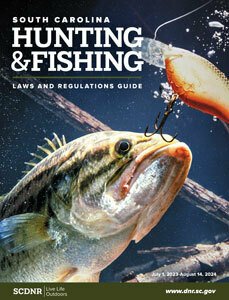Migratory Bird Baiting Laws
Baiting Laws
Federal rules prohibit the taking of migratory game birds by the aid of baiting, or on or over any baited area, where a person knows or reasonably should know that the area is or has been baited.
It is legal to take migratory game birds including waterfowl, coots and cranes, on or over the following lands or areas that are not otherwise baited areas:
- Standing crops or flooded standing crops (including aquatics);
- Standing, flooded or manipulated natural vegetation; flooded harvested croplands; or lands or areas where seeds or grains have been scattered solely as the result of a normal agricultural planting, harvesting, post-harvest manipulation or normal soil stabilization practice;
- - From a blind or other place of concealment camouflaged with natural vegetation;
- From a blind or other place of concealment camouflaged with vegetation from agricultural crops, as long as such camouflaging does not result in the exposing, depositing, distributing or scattering of grain or other feed; or
- - Standing or flooded standing agricultural crops where grain is inadvertently scattered solely as a result of a hunter entering or exiting a hunting area, placing decoys, or retrieving downed birds.
Who is responsible?
Hunters, guides and landowners are responsible for understanding and obeying regulations about baiting and knowing the conditions of the area to be hunted.
What is baiting?
Baiting means the direct or indirect placing, exposing, depositing, distributing or scattering of salt, grain, or other feed that could serve as a lure or attraction for migratory game birds to, on, or over any areas where hunters are attempting to take them.
What is a baited area?
A baited area is any area on which salt, grain or other feed has been placed, exposed, deposited, distributed or scattered, if that salt, grain or other feed could serve as a lure or attraction for migratory game birds to, on, or over areas where hunters are attempting to take them.
For how long?
An area is considered baited for ten days following the complete removal of all salt, grain or other feed.
What about normal agricultural operations?
Normal agricultural operation means a normal agricultural planting, harvesting, post-harvest manipulation or agricultural practice that is conducted in accordance with official recommendations of State Extension Specialists of the Cooperative Extension Service of the U.S. Department of Agriculture.
What is a normal soil stabilization practice?
A normal soil stabilization practice means a planting for agricultural soil erosion control or post-mining land reclamation conducted in accordance with official recommendations of State Extension Specialists of the Cooperative Extension Service of the U.S. Department of Agriculture for agricultural erosion control. Agricultural erosion control typically involves seeding prior to leaf drop or defoliation, mowing or shredding of crop residue to cover seed, or seeding prior to crop harvest to result in soil-seed contact and/or covering of the seed.
Top sowing of seed to control erosion on impoundment dikes, pond dams, roadways, logging decks, skid trails, power line rights-of-way, or construction sites may be considered erosion control if done according to Clemson Extension Service guidelines.
What is manipulation?
Manipulation means the alteration of natural vegetation or agricultural crops by activities that include, but are not limited to, mowing, shredding, disking, rolling, chopping, trampling, flattening, burning or herbicide treatments. The term manipulation does not include the distributing or scattering of grain, seed or other feed after removal from or storage on the field where grown.
What is considered natural vegetation?
Natural vegetation means any non-agricultural, native or naturalized plant species that grows at a site in response to planting or from existing seeds or other propagules. The term natural vegetation does not include planted millet. However, planted millet that grows on its own in subsequent years after the year of planting is considered natural vegetation.
Hunting over agricultural land?
Nothing in the baiting regulation prohibits the taking of any migratory game bird, including waterfowl, coots, and cranes, on or over standing crops or flooded standing crops (including aquatics); standing, flooded, or manipulated natural vegetation; flooded harvested croplands; or lands or areas where seeds or grains have been scattered solely as the result of a normal agricultural planting, harvesting, post-harvest manipulation or normal soil stabilization practice.
Hunting over agricultural land manipulated for wildlife management?
The baiting regulation does not prohibit the taking of any migratory game bird, EXCEPT waterfowl, coots and cranes, on or over lands or areas that are not otherwise baited areas, and where grain or other feed has been distributed or scattered solely as the result of manipulation of an agricultural crop or other feed on the land where grown, or solely as the result of a normal agricultural operation.
In order to understand the law’s application, the sportsman should know the legal definition of “take,” which refers to the attempt to take as well as the act of taking itself: “Take” means to pursue, hunt, shoot, wound, kill, trap, capture or collect, or attempt to pursue, hunt, shoot, wound, kill, trap, capture or collect.
Equally important to understanding the law is a familiarity with what is meant by normal agricultural operations: that is, what constitutes the recommended agricultural practices in South Carolina for planting corn, millet, wheat, sunflowers or other grains. The Clemson University Extension Service is the authority for this in South Carolina and publishes an agricultural planting guide annually. There is a Clemson Extension Service Office in almost every county.

